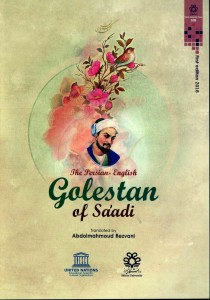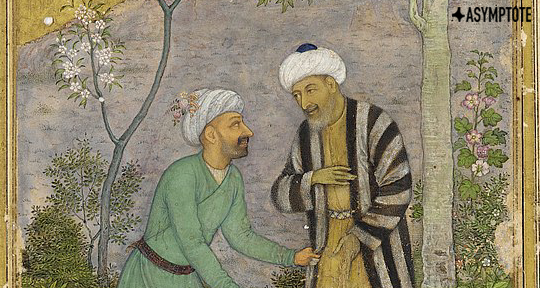In comparing various translations of the same text, one considers several factors—amongst them: accuracy, consistency, and the ease in which the secondary text reads in its newfound state. New translations of classic texts are further expected to provide knowledge and profundity that other extant translations missed. The writings of Persian poet Sa’di are intimately known and cherished in his original language, but its multiple iterations in English have each developed separate and, at times, misleading voices. In this following essay, writer and translator Siavash Saadlou discusses Mahmoud Rezvani’s new translation of Sa’di’s timeless Golestan, and how Rezvani’s insight into the book and his aptitude for translation have allowed his work to rise above its predecessors.

Yet Sa’di loved the race of men,—
No churl, immured in cave or den
In bower and hall, he wants them all,
Nor can dispense
With Persia for his audience;
They must give ear,
Grow red with joy and white with fear;
But he has no companion;
Come ten, or come a million,
Good Sa’di dwells alone.—Ralph Waldo Emerson
Mahmoud Rezvani’s new translation of Sa’di’s Golestan—a thirteenth-century literary lighthouse best known for its creative composition, moralistic maxims, and lush language—challenges the notion suggesting that fidelity and beauty are mutually exclusive in literary translation. When Rezvani, now in his mid-sixties, proposed the idea for the first time, the literati in Iran thought it “preposterous” and “impossible.” Their deeply held cynicism was derived in part from Golestan’s ornate Persian, mixed with bombastic Arabic and Qur’anic allusions, that render its prose and poetry extraordinarily labyrinthine. It also stemmed from Sa’di’s shrewd use of ambiguities and amphibologies as well as heteronyms and homographs throughout the work; and Sa’di’s rhymed prose (Saj’)—which can be divided into three categories: parallel, symmetrical, and lopsided—made the task ahead all the more formidable. Choosing le mot juste was yet another major hurdle to overcome. Sa’di was, after all, a writer best known for his impeccable, inimitable turn of phrase. His command over both Persian and Arabic was beyond compare; in fact, Sa’di was as recognized for his mastery of language as Hafiz was for his consummate ambiguity. The difficulty, therefore, lay in translating Sa’di’s wide palette of vocabularies as well as the supremely intriguing juxtaposition of images and ideas. Then there was the musicality which, though often ignored in Western translations, is the lifeblood of classical Persian literature. It is understandable, then, that it took Rezvani years to pluck up the courage to even consider translating Golestan and ten years to complete the endeavor.
Rezvani’s quest began with a simple question: Emerson and Thoreau were such admirers of Sa’di, when they had not been able to read Golestan in all its beauty. How much could they really have understood Sa’di? What would they have thought of a translation that was faithful and beautiful?
There were two English translations already, both from the nineteenth century, by James Ross and Edward Rehatsek respectively, that had abjectly failed to capture the musicality and the play of heteronyms and homographs. They even gravely misconstrued key words at times, making colossal mistakes that left the reader stupefied, as in James Ross’s translation of Canaan—meant to allude to Prophet Noah’s repudiated son in Sa’di’s Golestan—which he mistook for the biblical name for the ancient area of Palestine.
The only modern-day translation, by Wheeler M. Thackston in 2008, still struggled to improve upon its predecessors, as he also misjudged important homographs in the work, translating, for example, “mud” as “flower” (the two words are written the same in Persian) at one point. Similar to Ross’s and Rehatsek’s translations, Thackston’s is also bereft of Sa’di’s tune, giving classical Persian literature aficionados what can only be described as a lackadaisical version of Sa’di’s language. So, when Rezvani’s decade-long translation—what he calls a “labor of love”—was finished in 2018, fittingly published by the University of Shiraz, in Sa’di’s hometown, its remarkable coexistence of accuracy and elegance earned it an official UNESCO endorsement.
In a way, Rezvani was uniquely prepared for the task. His early education helped. During his formative years, Rezvani’s father, a beloved public figure in Isfahan—a city famous for its artistic tenor of life and solid tenets of tradition—insisted on rigorous education that went beyond the classroom. He read Sa’di to his son from the age of six and sent him to a school where he would master both Arabic and the Qur’an, which played a crucial role in his translation of Golestan. Rezvani studied statistics in college, and later switched to English language and literature for graduate school. He says his mathematical mind opened his eyes to the “horizontal” and “vertical” combinations in Sa’di’s work. It also allowed him to better comprehend the parallelisms and symmetries found in Golestan for the purpose of creating rhetorical effect. Furthermore, Rezvani’s training in awaz (traditional Persian singing) enabled him to achieve musicality in his translation while remaining loyal to the original text: The landlord’s concern is the peristyle’s decoration / while the house is rundown from the foundation.
Rezvani rarely resorts to “addition” and “insertion” strategies in his translation just for the sake of achieving rhyme, as is found in many other translations of Persian poetry (e.g.: Dick Davis’s Vis and Ramin). Instead, five decades of teaching English and Persian literature as well as being conversant with traditional Persian and classical Western music had primed him for the project. He is an exemplar of the intuitive translator—a translator whose wealth of experience allows him to sift through countless lexical choices on the spot; a translator who relies on his well-versed, multidisciplinary mind rather than instantly consulting the dictionary at every stop.
Stylistically speaking, Rezvani has made the interesting choice of using archaic pronouns and words in his verse translation and occasionally in prose. The intent is to remind the audience that Sa’di was a writer who lived almost eight hundred years ago, preserving a sense of mild antiquity not unlike reading Shakespeare in his own English. Rezvani’s translation is significant also for its approach to Sa’di’s Saj’ which, while written in prose, is lithely lyrical. Take, for example, the following, from Chapter V, On Love and Youth:
در عنفوان جوانی، چنان که افتد و دانی، با شاهدی سری و سرّی داشتم، به حکم آن که حَلقی داشت طَیبُ الادا و خَلقی کاالبدرِ اذا بَدا.
In the prime of my youth, as it happens and you know forsooth, with a handsome sweetheart I held a secret and a romance in the closet, for his throat created a melodious tune and his face was as beautiful as the full moon.
And here is James Ross’s translation which, in addition to having no musicality, distorts key parts from the original text:
In my early youth such an event (as you know) will come to pass. I held a mystery and intercourse with a young person, because he had a pipe of exquisite melody, and a form silver bright as the full moon.
Another example, in verse translation, from the same chapter, can be seen below, first by Edward Rehatsek and then by Mahmoud Rezvani.
Story XXI:
A gallant youth there was and fair
Pledged to a maid beyond compare
They on the sea, as poets tell,
Together in a whirlpool they fell.
The boatman came the youth to save—
To snatch him from watery grave:
But, ‘mid those billows of despair,
He cried, “My love! My love is there!
Save her, oh save!” he said, and died;
But with his parting breath he cried:
“Not from that wretch love’s story hear
Who love forgets when peril’s near.”
Together thus these lovers died,
Be told by him who love has tried;
For Sadi knows each whim and freak
Of love,–as well its ways can speak
As Baghdad’s dwellers Arabic.
Hast thou a mistress? Her then prize,
And on all others close thine eyes.
Could Majnoon and his Laila back return,
They might love’s story from this volume learn.
And below is Mahmoud Rezvani’s translation:
There once was a youth, handsome and well-disposed
Sitting with a damsel on a vessel calm and composed.
I have read that sailing on the great sea happy and cool,
Suddenly together they fell into a whirlpool.
As the sailor attempted to hold his hand,
Lest he might die in that lay of the land.
He kept saying from the midst of the waves and distress:
Let go of me and rescue my mistress.
While saying this, his world fell into disarray;
With his dying breath he was heard to say:
Hear not the story of love from the man of atrocity
Who will forget a beloved in time of adversity.
Thus were leading a life the true lovers;
Learn it from an old hand who everything covers.
As aware is Sa’di of all the ins and outs of lovemaking
As an Arab in Baghdad deems speaking Arabic so easy an undertaking.
To the heart-consoler thou hast, tie thy heart;
Let thy eyes be shut to any other sweetheart.
Should Majnoon of Laily come back from the dead,
He would let go of his love story and copy this one instead.
As can be seen, the two translations couldn’t have been more different. Based on the original Persian text, Rehatsek’s translation fails to reflect Sa’di’s words and strips the text of its tune. Rezvani’s translation, however, correctly conveys the meaning of Sa’di’s verse while offering a tuneful rhyme. Granted, there is room for improvement in terms of meter, but as Rezvani himself invokes a felicitous William Hazlitt quote, “the only impeccable writers are those who never wrote.” Rezvani’s effort is noteworthy for breathing fresh air into a manuscript written in 1258 CE and producing a translation that stays true to Sa’di’s original style which is deceptively simple. If we take John Dryden’s famous tripartite classification of translation methods into account, we can conclude that Rezvani somehow avoids “paraphrase” as his primary translation strategy, or “metaphrase” for that matter, because such applications would result in a travesty of Sa’di’s eloquence. Instead, his approach is a blend of paraphrasing and imitation methods while he is, consciously and consistently, wary of misrepresenting Sa’di.
Albert Einstein once famously said that “everything should be made as simple as possible, but not simpler.” Rezvani’s translation is not a simplification, and so cannot, as Ezra Pound once wrote in Guido’s Relations, “do all of the work for the linguistically lazy reader.” His translation requires more work on the part of the reader, as most classic literature does. But this does not detract from the work, so much as offer an opportunity to return to it again and again, perceiving a bit more and understanding a bit differently—as we do with so many other masterpieces and treasured works—drawing closer to the essence of what has allowed Sa’di’s work to captivate so many for centuries.
Siavash Saadlou is a writer and translator from Iran. His fiction has appeared in Margins and his poetry in Sons and Daughters, Scoundreltime, KAIROS, CIRQUE, and Saint Katherine Review. His translations of contemporary Persian poetry have been published in Washington Square Review, Visions International, Pilgrimage, and Asymptote, among other journals. Saadlou holds an MFA in creative writing from Saint Mary’s College of California. He lives in Tehran, teaching translation and creative writing workshops.
*****
Read more on the Asymptote blog:

